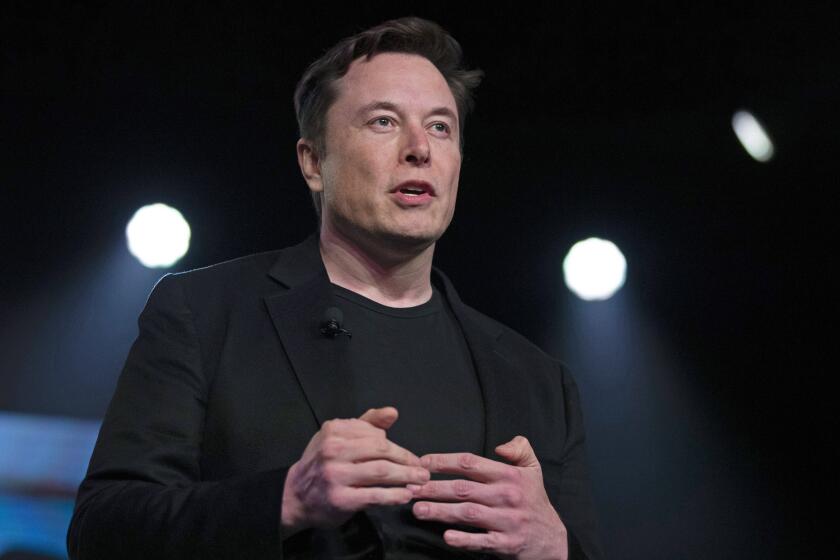Q&A: Amazon is making ‘Breakaway’ and other video games to show off Twitch and the cloud
- Share via
Amazon.com’s first big-budget video game is like street basketball, except played in a mythological world where athletes are armed.
Wait, Amazon makes video games? Indeed, the leader in online shopping branched into video game development a few years ago. With the unveiling last month of multiplayer online battle sport “Breakaway,” Amazon for the first time showed how its gaming acquisitions and initiatives tie together.
The PC game integrates into Twitch, the live video streaming app Amazon bought for nearly $1 billion, unlike any game from anyone ever before. “Breakaway” also showcases Lumberyard — a free software package that Amazon designed for game developers to build on because it connects to Amazon Web Services, a fee-based cloud storage system.
Mike Frazzini, Amazon Games vice president, and Patrick Gilmore, head of the company’s Irvine development studio, said “Breakaway” will become available for free indefinitely for people to test as Amazon squashes bugs. In a cramped corner at Twitch’s bustling fan convention in San Diego, they went deeper into how “Breakaway” came to be and what to expect from Amazon Games. The interview has been edited for length and clarity.
What’s the big-picture philosophy of Amazon Games?
Frazzini: Everyone wants it to be a thing, but it’s really a collection of things and us obsessing about customers.
We view the cloud and shared experiences as being historically the past, present and future of games. If you think about what makes games so fantastic, it’s the experiences you have with your friends. A long time ago it was in arcades, then over local networks, then online and now you have Twitch and e-sports and modding and cosplay. They are all about shared experiences.
How did you get into buying Twitch and Irvine video game maker Double Helix?
Frazzini: One of our leadership principles is think big, see around corners. Four, five, six years ago, one of the things we were very enamored with is how vibrant communities are around games.
In thinking about developing game technology to enable those experiences, we met a lot of game developers and what impressed us about [then-Double Helix executive Gilmore] was three things.
They were bringing in pro players for hours of testing and feedback. They obsessed over customers early on. Second, we thought their technology was solid. A lot of Lumberyard came from Double Helix, to construct fantastic animations. Third, they were on the rise. We felt we were catching them before anyone.
We knew the Twitch guys for years, and we always wanted a way to work together. We have a lot of gamers inside the company, so we were just fans of the service. And being in the industry, we got a chance to meet them.
So you marry this community-centricity and this craft of incredible game making — that in our opinion was moving up and to the right — with their ambition to build Lumberyard, and it just sort of all threads together.
How did you get into gaming?
Frazzini: I grew up in the ’80s and ’90s playing PC and console games. I had a PC retail business in Chicago, and we used to build PC gaming rigs for people, so I can tell you a lot about late ’90s graphics processors. I joined Amazon in 2004. In 2009, I was asked to run our games business. And I was like, “Touchdown!”
What stands out about the way Double Helix, or Amazon Game Studios Orange County, develops games?
Gilmore: The word that jumps to my head is unentitled.
From the very beginning, there was this idea of short session rounds for “Breakaway.” But the game back then was offense versus defense.
But [players in testing] said, “I want to be playing both offense and defense.” One of the most junior developers on the team was the first guy that knocked out a map that was perfectly symmetrical and both teams were trying to steal something from the middle at the same time. The initial knee-jerk was, “No, that’s not what we’re making.” But the team had the humility to say, “Let’s play it.” [After] one 90-minute play session, everyone pointed to that one where you can play offense and defense simultaneously. Right there on the spot, that’s the direction the game went.
You don’t get that if you have a creative director that says, “You have to do it this way. It has to be the way I thought of this game.” This is a higher level of expertise to have a vision but to be able to incorporate really big new ideas.
You bring in expert gamers for testing, but what about the average consumer?
Gilmore: We do both. The first prototype we built and tested we had a deep fighting system. Expert gamers thought it was wonderful. More casual customers struggled with it. The skill gap was enormous, which you want, but the barrier of entry was hard for casual gamers. The team scrapped the entire thing and redesigned it. On the show floor, you’re seeing evidence it’s a lot more accessible.
Could ‘Breakaway’ be an e-sport, where fans watch matches for fun?
Gilmore: That’s for the community to decide. But as I consider what defines a sport, it’s moments of athletic prowess that spectators can’t predict. The first time you see a reverse dunk in basketball, the first time you see a running back leap over a defensive back in football.
In the exhibition match [last week], one of the guys did a move that really required understanding the game. When you pass the relic [ball] and there’s no one to pass to, it goes straight up. He had a character that double jumps so he popped up the relic, activated his jump, caught it in mid-air, [loaded up for] a shot, did the second jump and from his apex scored a goal from really far away. Literally, no one had made a shot from that faraway [before.] We were in the audience saying, ‘What did he just do? What did he just do?’
Will you foster e-sports?
Gilmore: We absolute want to support tournaments. What you’ll see from us is probably more grassroots.
One of the new Twitch features lets viewers bet while watching a match. How did that come about?
Gilmore: If you’re a streamer on Twitch, there’s a chat box where you can respond to viewers [here and there]. We wanted to create a system for broadcasters to interact with larger numbers of viewers at one time.
Stream+ is a loyalty system. The loyalty points don’t move from one broadcaster to another. You can earn points participating in polls, or just by watching. And you can use points to say, who do you think is going to win the match? You can say, I think red team is going to win, or blue team is going to win. And if you win, you get more points. The points you can redeem for special skins in the game. They’re a status aspect in the game. The system was inspired by streamers who were [patching together] loyalty systems on their own.
How will ‘Breakaway’ make money? There’s no price or revenue model announced yet.
Gilmore: It’s clearly built around characters. But we’re in alpha, and we’re going to learn a lot about what’s best for this game.
Frazzini: It isn’t black and white to us. It’s not free to play or freemium. We think there’s a lot of room for invention and doing creative things in between, especially in the context of broadcasters. Maybe we'll do something typical. Maybe we'll do something a lot different.
How do you sum up what types of games you’re trying to build?
Frazzini: The Twitch community has already changed the experience of games. And what we think is next for the Twitch community is [to] change the way games are made. We don’t start our exercises with genres. We think of doing something really different and exploring this frontier of Twitch and community-driven games. We’re not going to succeed all the time because experiments don’t always succeed.
Gilmore: We want to make games that have the potential to be really big, but also we want to make something that’s brand new. “Go out early, listen to customers” is our strategy for doing that, for making these really big bets.
Twitter: @peard33




